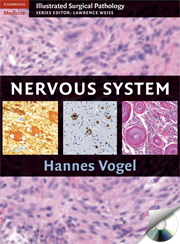Book contents
- Frontmatter
- Contents
- Contributors
- Preface
- Acknowledgments
- 1 Normal Anatomy and Histology of the CNS
- 2 Intraoperative Consultation
- 3 Brain Tumors
- Brain Tumors – An Overview
- Brain Tumor Locations with Respect to Age
- Grading Brain Tumors
- NEUROEPITHELIAL
- TUMORS OF CRANIAL AND PARASPINAL NERVES
- TUMORS OF THE MENINGES
- LYMPHOMAS AND HEMATOPOIETIC NEOPLASMS
- GERM CELL TUMORS
- NONNEOPLASTIC MASSES AND CYSTS
- PATHOLOGY OF THE SELLAR REGION
- METASTATIC NEOPLASMS OF THE CENTRAL NERVOUS SYSTEM
- SKULL AND PARASPINAL NEOPLASMS, NONNEOPLASTIC MASSES, AND MALFORMATIONS
- CNS-RELATED SOFT TISSUE TUMORS
- 4 Vascular and Hemorrhagic Lesions
- 5 Infections of the CNS
- 6 Inflammatory Diseases
- 7 Surgical Neuropathology of Epilepsy
- 8 Cytopathology of Cerebrospinal Fluid
- Index
TUMORS OF THE MENINGES
from 3 - Brain Tumors
Published online by Cambridge University Press: 04 August 2010
- Frontmatter
- Contents
- Contributors
- Preface
- Acknowledgments
- 1 Normal Anatomy and Histology of the CNS
- 2 Intraoperative Consultation
- 3 Brain Tumors
- Brain Tumors – An Overview
- Brain Tumor Locations with Respect to Age
- Grading Brain Tumors
- NEUROEPITHELIAL
- TUMORS OF CRANIAL AND PARASPINAL NERVES
- TUMORS OF THE MENINGES
- LYMPHOMAS AND HEMATOPOIETIC NEOPLASMS
- GERM CELL TUMORS
- NONNEOPLASTIC MASSES AND CYSTS
- PATHOLOGY OF THE SELLAR REGION
- METASTATIC NEOPLASMS OF THE CENTRAL NERVOUS SYSTEM
- SKULL AND PARASPINAL NEOPLASMS, NONNEOPLASTIC MASSES, AND MALFORMATIONS
- CNS-RELATED SOFT TISSUE TUMORS
- 4 Vascular and Hemorrhagic Lesions
- 5 Infections of the CNS
- 6 Inflammatory Diseases
- 7 Surgical Neuropathology of Epilepsy
- 8 Cytopathology of Cerebrospinal Fluid
- Index
Summary
Meningiomas
Clinical and Radiological Features
Meningiomas are defined as meningeal tumors arising from meningothelial arachnoid cells, typically arising at the inner surface of the dura mater. They show a staggering diversity of locations, growth patterns, and histologic variations such that in both the neuroanatomical and histological senses they are the great mimicker of many other pathological entities.
Meningiomas account for approximately 30% of all primary brain tumors and are thus the single most common “brain” tumor, excluding glioblastoma as the most common glioma, in persons over the age of 35 years (Claus et al., 2005). In middle-aged adults, meningiomas are distinctly more common in females (Longstreth et al., 1993). Spinal meningiomas are also more common in women (Cohen-Gadol et al., 2003), accounting for almost 90% in some series among the older patients (Gezen et al., 2000).
Meningiomas are also recognized in childhood and represent the most common dural or leptomeningeal based neoplasm in this age group. Pediatric meningiomas may be characterized by large size at diagnosis, cyst formation, intraparenchymal location and high-grade histology, aggressive behavior, particularly in the clear cell and papillary variants (Perry and Dehner, 2003; Rushing et al., 2005). Unlike in adults, there is a male predilection in pediatric meningiomas. Pediatric meningiomas are also within the spectrum of postirradiation tumors.
Multiple meningiomas are a cardinal feature of NF2 and occur in half of NF2 patients (Louis et al., 1995). Forty percent of pediatric patients with meningioma have NF2 (Perry and Dehner, 2003).
- Type
- Chapter
- Information
- Nervous System , pp. 201 - 222Publisher: Cambridge University PressPrint publication year: 2009

